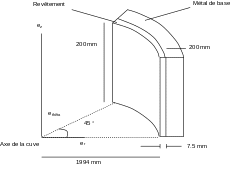1. Reference problem#
1.1. Geometry#
The geometry studied is that of a bi-metal tank slice, limited to 45 degrees in azimuth.

1.1.1. Defect considered#
In method \(K\beta\), the defect is not modeled in the mesh. The mesh makes it possible to calculate the stresses at the nodes. A post-processing is then applied to calculate the stress intensity factor by the \(\beta\) method from the stresses at the nodes (the method is detailed in [R7.02.10]).
For this test, the defect in question is elliptical and has a longitudinal orientation. Its dimensions are as follows (see figure below):
depth: \({\mathit{prof}}_{\text{def}}\mathrm{=}\mathrm{6mm}\)
width: \(\mathrm{2b}\mathrm{=}\mathrm{60mm}\)
offset in the coating: \(\mathit{deca}\mathrm{=}–\mathrm{0,2}\mathit{mm}\)
1.2. Material properties#
For thermal calculation:
Two properties are specified, they are:
LAMBDA: isotropic thermal conductivity as a function of temperature, expressed in \({\mathit{W.m}}^{\mathrm{-}1}\mathrm{.}{K}^{\mathrm{-}1}\),
BETA: volume enthalpy as a function of temperature, expressed in \({\mathit{J.m}}^{\mathrm{-}3}\).
For coating:
Temperature ( \(°C\) ) |
LAMBDA |
0 |
14.7 |
20 |
14.7 |
50 |
15.2 |
100 |
15.8 |
150 |
16.7 |
200 |
17.2 |
250 |
18 |
300 |
18.6 |
350 |
19.3 |
Temperature ( \(°C\) ) |
BETA |
0 |
0.000000.E+00 |
50 |
1.102100.E+08 |
100 |
3.013300.E+08 |
150 |
5.014300.E+08 |
200 |
7.081300.E+08 |
250 |
9.188800.E+08 |
300 |
1.132910.E+09 |
350 |
1.348980.E+09 |
For the base metal:
Temperature ( \(°C\) ) |
LAMBDA |
0 |
37.7 |
20 |
37.7 |
50 |
38.6 |
100 |
39.9 |
150 |
40.5 |
200 |
40.5 |
250 |
40.2 |
300 |
39.5 |
350 |
38.7 |
Temperature ( \(°C\) ) |
BETA |
0 |
0.000000.E+00 |
50 |
1.061900.E+08 |
100 |
2.903300.E+08 |
150 |
4.829100.E+08 |
200 |
6.832800.E+08 |
250 |
8.921600.E+08 |
300 |
1.109440.E+09 |
350 |
1.335060.E+09 |
For mechanical calculation:
Four parameters are filled in, they are:
|
Young’s modulus, expressed in \(\mathit{Pa}\), |
|
Poisson’s ratio, |
|
isotropic thermal expansion coefficient, expressed in \(°C\), |
|
value of the temperature at which the values of the thermal expansion coefficient ALPHAont were determined, expressed in \(°C\). |
For coating:
Temperature ( \(°C\) ) |
\(E\) |
0 |
1.985E+11 |
20 |
1.97E+11 |
50 |
1.95E+11 |
100 |
1.915E+11 |
150 |
1.875E+11 |
200 |
1.84E+11 |
250 |
1.8E+11 |
300 |
1.765E+11 |
350 |
1.72E+11 |
Modeling a |
Modeling b |
|||
Temperature ( \(°C\) ) |
ALPHA |
Temperature ( \(°C\) ) |
ALPHA |
|
0 |
1.756E-05 |
|||
20 |
1.764E-05 |
20 |
1.64E-05 |
|
50 |
1.7787E-05 |
50 |
1.654E-05 |
|
100 |
1.8019E-05 |
100 |
1.68E-05 |
|
150 |
1.8225E-05 |
150 |
1.704E-05 |
|
200 |
1.8575E-05 |
200 |
1.72E-05 |
|
250 |
1.8568E-05 |
250 |
1.75E-05 |
|
300 |
1.8768E-05 |
300 |
1.777E-05 |
|
For the base metal:
Temperature ( \(°C\) ) |
\(E\) |
0 |
2.05E+11 |
20 |
2.04E+11 |
50 |
2.03E+11 |
100 |
2E+11 |
150 |
1.97E+11 |
200 |
1.93E+11 |
250 |
1.89E+11 |
300 |
1.85E+11 |
350 |
1.8E+11 |
Modeling A |
B Modeling |
|||
Temperature ( \(°C\) ) |
ALPHA |
Temperature ( \(°C\) ) |
ALPHA |
|
0 |
1.2878E-05 |
|||
20 |
1.3002E-05 |
20 |
1.122E-05 |
|
50 |
1.3198E-05 |
50 |
1.145E-05 |
|
100 |
1.3521E-05 |
100 |
1.179E-05 |
|
150 |
1.382E-05 |
150 |
1.214E-05 |
|
200 |
1.4102E-05 |
200 |
1.247E-05 |
|
250 |
1.4382E-05 |
250 |
1.278E-05 |
|
300 |
1.4682E-05 |
300 |
1.308E-05 |
|
1.3. Boundary conditions and loads#
The boundary conditions imposed are those of an axisymmetric system.
Two types of loads are applied:
heat exchange in the inner skin,
fluid pressure in the inner skin.